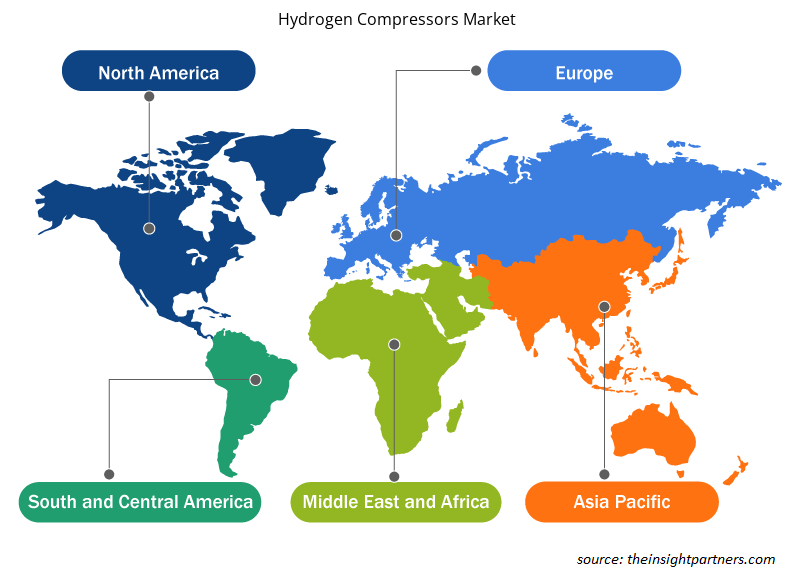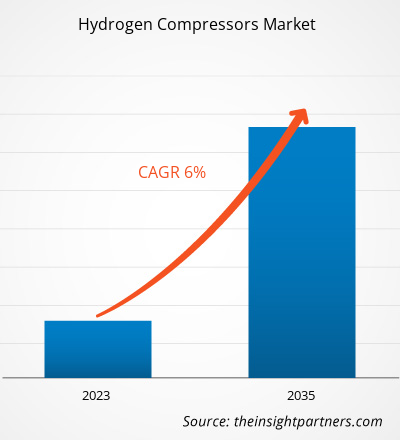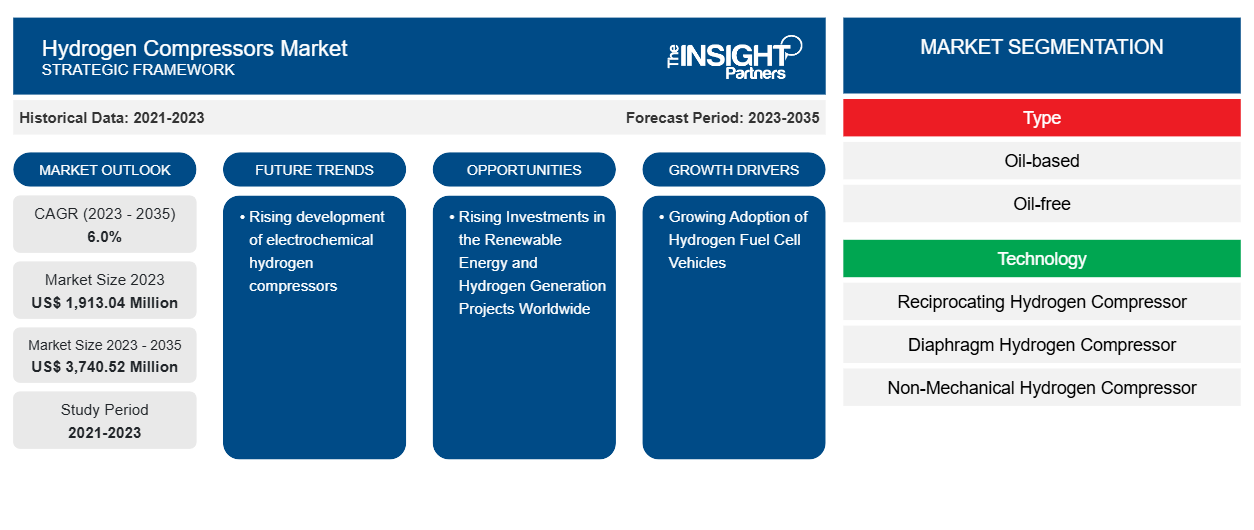预计到 2035 年,氢气压缩机市场规模将从 2023 年的 19.1304 亿美元增至 37.4052 亿美元。预计 2023-2035 年期间市场复合年增长率将达到 6.0%。未来几年,向绿色氢气的转变可能会给市场带来新的趋势。
氢气压缩机市场分析
预计未来几年,氢燃料电池汽车的普及以及全球石油和天然气、化工和石化行业的迅猛发展将推动对氢气压缩机的需求。此外,氢气压缩机市场目前的增长归因于先进氢气压缩机的引入。然而,氢气压缩机的高安装和维护成本阻碍了市场的增长。此外,预计全球能源行业投资的增加以及氢气基础设施的开发和扩张将为预测期内氢气压缩机市场的主要参与者创造机会。此外,预计各行业转向使用绿色氢气将成为未来市场的主要趋势。
由于政府举措和资金的增加,可再生能源领域的投资有所增加,从而推动了氢气压缩机的采用。根据国际能源署的数据,2023 年前六个月,全球对可再生能源领域的投资达到 3580 亿美元,比去年年初增长 22%,创下六个月以来的历史新高。可再生能源公司与去年(2022 年)相比。风险投资公司和私募股权公司正在扩大其在可再生能源领域的业务,2023 年第一季度达到 104 亿美元。中国在 2023 年第一季度占据了最大的市场份额,投资额达到 1770 亿美元,比 2022 年第一季度增长了 16%。此外,美国获得了约 360 亿美元的投资,其次是德国,投资 119 亿美元用于扩大可再生能源部门。
氢气压缩机市场概况
氢气是最节能的燃料之一,单位重量的能量含量最高,在环境条件下密度为每立方米 90 克。为了达到功能性的能量密度水平,需要对氢气进行高效压缩。氢气压缩机可有效地将少量至中等量的氢气压缩至高值。根据要求,氢气压缩机也用于极高压力;例如,高于 5,000 巴(75,000 PSI)。此外,压缩大量无油氢气需要低于 250 巴(3,600 PSI)的压力,这反过来又有望在预测期内推动对氢气压缩机的需求。
定制此报告以满足您的需求
您可以免费定制任何报告,包括本报告的部分内容、国家级分析、Excel 数据包,以及为初创企业和大学提供优惠和折扣
- 获取此报告的关键市场趋势。这个免费样品将包括数据分析,从市场趋势到估计和预测。
氢气压缩机市场驱动因素和机遇
氢燃料电池汽车的普及率不断提高
由于人们越来越担心自然资源枯竭和环境恶化,世界各国政府不断致力于为包括汽车在内的各个行业开发环保解决方案。此外,由于对空气污染影响的认识不断提高,以及交通和温室气体排放量不断增加,消费者偏好也发生了变化,推动了对氢燃料电池汽车的需求。政府对氢燃料基础设施的投资增加以及向买家提供的激励措施使原始设备制造商 (OEM) 能够扩大其收入来源和地理分布。例如,印度政府于 2023 年 1 月启动了国家绿色氢能计划,投资约 20 亿美元。此外,全球汽车制造商的研发活动也在增加。例如,2020 年 12 月,丰田推出了重新设计的 Mirai。该公司更新了各种内部和外部功能,包括其氢燃料电池系统。
与传统内燃机汽车相比,氢燃料电池汽车具有多种优势。燃料电池电动汽车 (FCEV) 为内燃机 (ICE) 汽车提供了更好的燃油经济性。FCEV 的燃油经济性约为每加仑汽油当量 (MPGge) 63 英里,而 ICE 汽车在道路上的 MPGge 为 29。混合动力可将 FCEV 的燃油经济性提高约 3.2%。此外,FCEV 无需加油即可行驶近 300 英里。本田 Clarity 在美国所有零排放汽车中拥有最高的 EPA 驾驶评级。它的续航里程可达 366 英里。由于这些优势,对氢燃料电池汽车的需求有所增加。例如,根据 2024 年 5 月发表的一篇研究论文中提供的数据,韩国 (19,270) 和美国 (12,283) 是乘用车、公共汽车和卡车领域燃料电池汽车采用率领先的国家。政府的激励措施和氢动力汽车主要参与者的产品开发活动,导致对氢动力基础设施的需求增加,最终推动了市场的发展。FCEVs) provide improved fuel economy to internal combustion engine (ICE) vehicles. The FCEV has a fuel economy of ~63 miles per gallon gasoline equivalent (MPGge), and an ICE vehicle records 29 MPGge on roads. Hybridization enhances the fuel economy of an FCEV by approximately 3.2%. Moreover, the FCEVs can travel almost 300 miles without refueling. Honda Clarity has the highest EPA driving rating for any zero-emission vehicle in the US. It has a driving range of up to 366 miles. Owing to these benefits, the demand for hydrogen fuel cell vehicles has increased. For instance, as per the data presented in a research paper published in May 2024, South Korea (19,270) and the US (12,283) are the leading countries in fuel cell vehicle adoption in the passenger car, buses, and truck segments. Government incentives and product development activities by key players for hydrogen vehicles are leading to increased demand for hydrogen infrastructure, ultimately driving the market.
全球可再生能源和氢气发电项目投资不断增加
随着城市化进程加快和工业快速增长,全球能源消耗激增。为了满足巨大的电力需求,氢能发电项目的启动迅速增加。根据 Ember 气候组织的数据,2022 年第一季度全球能源总需求达到约 13,393 TWh,较 2021 年的 13,004 TWh 有所增加。由于住宅和工业制造需求不断增长,能源和电力需求的增加推动了对氢气压缩机的需求。可再生能源在发电方面发挥着重要作用。根据国际能源署 (IEA) 的数据,到 2040 年,全球电力需求预计将每年增长 2.1%。TWh in the first quarter of 2022, an increase from 13,004 TWh compared to 2021. Such an increase in demand for energy and power, owing to rising residential and industrial manufacturing requirements, is driving the demand for hydrogen compressors. Renewable energy plays a significant role in making electricity. Per the International Energy Agency (IEA), the global demand for electricity is anticipated to increase by 2.1% annually by 2040.
氢气压缩机市场报告细分分析
有助于得出氢气压缩机市场分析的关键部分是类型、技术和最终用户。
- 根据类型,氢气压缩机市场分为润滑和无油两类。2023 年,润滑部分占据了更大的市场份额。
- 根据技术,氢气压缩机市场分为往复式氢气压缩机、隔膜式氢气压缩机、非机械式氢气压缩机等。往复式氢气压缩机在 2023 年占据了市场主导地位。nonmechanical hydrogen compressors, and others. The reciprocating hydrogen compressors segment dominated the market in 2023.
- 根据最终用户,市场分为发电厂、石油和天然气、食品和饮料、石化和化学品、加氢站、氢气储存等。石化和化工部门在 2023 年占据了最大的市场份额。
氢气压缩机市场份额按地区分析
氢气压缩机市场报告的地理范围主要分为五个区域:北美、亚太、欧洲、中东和非洲、南美和中美。
北美氢气压缩机分为美国、加拿大和墨西哥。市场增长归因于石油和天然气行业的增长对氢气压缩机的巨大需求。包括美国和加拿大在内的发达国家完善的基础设施有助于制造企业探索科学、技术和商业的极限。技术进步导致该地区制造业的竞争激烈。根据美国国家标准与技术研究所 (NIST) 的数据,2023 年美国制造业的价值为 2.9 万亿美元,占其 GDP 总量的 10.0%。这些突出的制造业和工业部门在北美对氢气作为清洁燃料产生了巨大的需求,这反过来预计将在预测期内推动氢气压缩机市场的发展。NIST), the manufacturing sector in the US was valued at US$ 2.9 trillion in 2023, accounting for a 10.0% share of its total GDP. Such prominent manufacturing and industrial sectors generate a vast demand for hydrogen as a clean fuel in North America, which, in turn, is projected to boost the hydrogen compressor market during the forecast period.
美国每年生产约 1000 万公吨氢气,主要用于石油精炼和氨生产。氢气在化学过程、清洁能源系统和运输等应用中具有巨大的潜力,可实现零排放运营。氢气也正在成为数据中心、港口、钢铁制造设施以及中型和重型卡车运行中一种有吸引力的燃料。2023 年 1 月,能源部 (DOE) 宣布作为基础设施投资和就业法案的一部分,向区域清洁氢中心 (H2Hubs) 投资 80 亿美元。这些 H2Hubs 将展示整个清洁氢价值链,促进生产、加工、交付、存储和最终用途应用。能源部的努力与拜登政府的雄心勃勃的目标相一致,即到 2035 年实现无碳电网,到 2050 年过渡到净零排放经济。这笔资金旨在加速氢技术和基础设施的进步,推动美国朝着更可持续和更环保的未来迈进。DOE's efforts align with the Biden Administration's ambitious targets of achieving a carbon-free electric grid by 2035 and transitioning to a net-zero emissions economy by 2050. The funding aims to accelerate advancements in hydrogen technology and infrastructure, driving progress toward a more sustainable and environmentally friendly future in the US.
氢气压缩机市场区域洞察
Insight Partners 的分析师已详细解释了预测期内影响氢气压缩机市场的区域趋势和因素。本节还讨论了北美、欧洲、亚太地区、中东和非洲以及南美和中美洲的氢气压缩机市场细分和地理位置。

- 获取氢气压缩机市场的区域特定数据
氢气压缩机市场报告范围
| 报告属性 | 细节 |
|---|---|
| 2023 年的市场规模 | 19.1304亿美元 |
| 2035 年市场规模 | 37.4052亿美元 |
| 全球复合年增长率(2023 - 2035) | 6.0% |
| 史料 | 2021-2023 |
| 预测期 | 2023-2035 |
| 涵盖的领域 | 按类型
|
| 覆盖地区和国家 | 北美
|
| 市场领导者和主要公司简介 |
|
氢气压缩机市场参与者密度:了解其对业务动态的影响
氢气压缩机市场正在快速增长,这得益于终端用户需求的不断增长,而这些需求又源于消费者偏好的不断变化、技术进步以及对产品优势的认识不断提高等因素。随着需求的增加,企业正在扩大其产品范围,进行创新以满足消费者的需求,并利用新兴趋势,从而进一步推动市场增长。
市场参与者密度是指在特定市场或行业内运营的企业或公司的分布情况。它表明在给定市场空间中,相对于其规模或总市场价值,有多少竞争对手(市场参与者)存在。
在氢气压缩机市场运营的主要公司有:
- 布克哈特压缩公司
- 阿特拉斯·科普柯公司
- Fluitron 公司
- 豪顿集团
- 加德纳丹佛纳什
- 有限责任公司
免责声明:上面列出的公司没有按照任何特定顺序排列。

- 了解氢气压缩机市场顶级关键参与者概况
氢气压缩机市场新闻和最新发展
通过收集一手和二手研究后的定性和定量数据来评估氢气压缩机市场,其中包括重要的公司出版物、协会数据和数据库。氢气压缩机市场的一个关键发展如下:
- Howden 签署了为加利福尼亚州里士满的 Raven SR 可再生氢气生产设施提供三台氢气隔膜压缩机的合同。(来源:Howden,新闻稿,2022 年 6 月)
氢气压缩机市场报告覆盖范围和交付成果
“氢气压缩机市场规模和预测(2021-2035)”报告对以下领域进行了详细的市场分析:
- 氢气压缩机市场规模及全球、区域和国家层面所有主要细分市场的预测
- 氢气压缩机市场趋势,以及驱动因素、限制因素和关键机遇等市场动态
- 详细的 PEST 和 SWOT 分析
- 氢气压缩机市场分析涵盖主要市场趋势、全球和区域框架、主要参与者、法规和最新市场发展
- 行业格局和竞争分析,涵盖市场集中度、热图分析、知名参与者以及氢气压缩机市场的最新发展
- 详细的公司简介
- 历史分析(2 年)、基准年、预测(7 年)及复合年增长率
- PEST和SWOT分析
- 市场规模、价值/数量 - 全球、区域、国家
- 行业和竞争格局
- Excel 数据集
近期报告
客户评价
购买理由
- 明智的决策
- 了解市场动态
- 竞争分析
- 客户洞察
- 市场预测
- 风险规避
- 战略规划
- 投资论证
- 识别新兴市场
- 优化营销策略
- 提升运营效率
- 顺应监管趋势





















 获取免费样品 - 氢气压缩机市场
获取免费样品 - 氢气压缩机市场